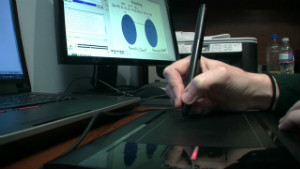Is the Internet hurting children?
updated 10:04 AM EDT, Mon May 21, 2012

Chelsea Clinton and James Steyer says there's evidence that the explosion of computer use has changed the way kids think.
STORY HIGHLIGHTS
- Chelsea Clinton and James Steyer say we must ask: How are social media effecting kids?
- They say explosion of online access for kids has opened Pandora's box of privacy issues
- They say it's changed the way kids think, interact with others; discretion is abandoned
- Writers: We need laws, norms, education to maximize benefit, minimize disasters of online use
Editor's note: Chelsea
Clinton is a board member of Common Sense Media, a nonprofit advocacy
organization focused on media and technology's effects on children and
teens, and wrote the foreword to "Talking Back to Facebook." James P.
Steyer is founder and CEO of Common Sense Media and the author of "Talking Back to Facebook."
(CNN) -- Amid the buzz over the Facebook IPO, the
ever-evolving theories about how Twitter is reshaping our communications
and speculation about where the next social media-enabled protest or
revolution will occur, there is an important question we've largely
ignored. What are the real effects of all this on the huge segment of
the population most affected by social media themselves: our children
and our teens?
The explosive growth of
social media, smartphones and digital devices is transforming our kids'
lives, in school and at home. Research tells us that even the youngest
of our children are migrating online, using tablets and smartphones,
downloading apps. Consumer Reports reported
last year that more than 7.5 million American kids under the age of 13
have joined Facebook, which technically requires users to be 13 years
old to open an account. No one has any idea of what all of this media
and technology use will mean for our kids as they grow up.
By the time they're 2 years old, more than 90% of all American children have an online history. At 5, more than 50% regularly interact with a computer or tablet device, and by 7 or 8, many kids regularly play video games.
Teenagers text an average of 3,400 times a month. The fact is, by
middle school, our kids today are spending more time with media than
with their parents or teachers, and the challenges are vast: from the
millions of young people who regret by high school what they've already
posted about themselves online to the widely documented rise in
cyberbullying to the hypersexualization of female characters in video
games.

Chelsea Clinton
These challenges also
include traditional media and the phenomenon of "ratings creep" in the
movies that our kids consume. Movies today -- even G-rated ones --
contain significantly more sex and violence, on average, than movies
with the same rating 10 or 20 years ago.

James P. Steyer
The impact of heavy media
and technology use on kids' social, emotional and cognitive development
is only beginning to be studied, and the emergent results are serious.
While the research is still in its early stages, it suggests that the
Internet may actually be changing how our brains work. Too much hypertext and multimedia content
has been linked in some kids to limited attention span, lower
comprehension, poor focus, greater risk for depression and diminished
long-term memory.
Our new world of digital
immersion and multitasking has affected virtually everything from our
thought processes and work habits to our capacity for linear thinking
and how we feel about ourselves, our friends and even strangers. And it
has all happened virtually overnight.
 From PCs in school to online schooling
From PCs in school to online schooling
 Should you bet on Mark Zuckerberg?
Should you bet on Mark Zuckerberg?
It goes without saying
that digital media have also altered our fundamental notions of and
respect for privacy. Young people now routinely post and share private,
personal information and opinions on social media platforms without
fully considering the potential consequences.
The immediacy of social
media platforms, coupled with vulnerable youngsters who are socially
inexperienced and not fully developed emotionally, can create a
combustible mix. Kids often self-reveal before they reflect, and
millions of kids say and do things they later regret. The permanence of
what anyone posts online and the absence of an "eraser" button mean that
the embarrassment and potential damage can last forever.
We urgently need a public
conversation in our country among key stakeholders: parents, educators,
technology innovators, policymakers and young people themselves. The
dialogue must focus on the ways social media and technology enable our
kids to give up their privacy before they fully understand what privacy
is and why it's important to all of us. We should also discuss how
social media can help empower kids to find their voice, find their
purpose and potentially create the next technology revolution.
All adults know that the
teen years are a critical time for identity exploration and
experimentation. Yet this important developmental phase can be
dramatically twisted when that identity experimentation, however
personal and private, appears permanently on one's digital record for
all to see.
In the 1990s, as a
reaction to an explosion of television programming of increasingly
questionable quality for kids, Congress passed the Children's Television
Act. There was universal recognition that given all the time kids were
spending in front of the television, the nation had a collective
responsibility to offer positive, educational programming with limited
commercials. We are at, arguably, an even more important crossroads when
it comes to digital media and technology.
Howard Gardner, a
professor and researcher at the Harvard Graduate School of Education who
developed the concept of multiple intelligences, calls kids' use of
digital media and technology "epochal change." He compares the
revolution in digital media to the invention of the printing press
because of its extraordinary impact on the way we communicate, share
information and interact with one another. As a society, we have no
choice but to engage with this new reality and work to ensure that it
affects our kids in healthy, responsible ways.
The promise of digital
media to transform our lives in positive ways is enormous. If managed
well, technology can improve our schools and education, deepen social
connectedness, expand civic engagement and even help advance our
democracy. But for these positive outcomes to occur, we as a society
must confront the challenges endemic in our 24/7 digital world.
We need legislation,
educational efforts and norms that reflect 21st-century realities to
maximize the opportunities and minimize the risks for our kids. Only
then will we be able to give them the safe, healthy childhood and
adolescence they deserve.
What do you think our public schools should do to prepare our children for these technological advances?











